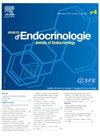新型催乳素免疫分析法分析性能及催乳素敏感性评价。
IF 2.9
3区 医学
Q3 ENDOCRINOLOGY & METABOLISM
引用次数: 0
摘要
目的:催乳素测定在内分泌诊断中具有重要意义。诸如钩效应和对催乳素的反应性等挑战,因试剂而异,使准确测量复杂化。本研究评估了一种新上市的催乳素检测试剂IDS prolactin,将其与现有试剂Roche Elecsys prolactin进行比较,评估其对巨催乳素和聚乙二醇(PEG)治疗的行为,并建立参考区间。方法:采用凝胶过滤层析确证的44份含有巨催乳素的样品(巨催乳素:BBPRL)和104份未诊断巨催乳素的样品(单体催乳素:MNPRL),比较IDS催乳素和罗氏Elecsys催乳素检测结果。还对IDS催乳素法的分析性能进行了评价。结果:新试剂具有良好的分析性能,重复性和中间不精密度均满足EFLM标准。两种方法的比较发现单体样品的相关性很强(y=1.060x-18.28;r2 = 0.993)。罗氏法对催乳素的反应特别低,与之相比,IDS法显示出更高的检测水平。当回收率为65%的临界值或后PEG单体催乳素正常上限阈值为444 mIU/L(20.9µg/L)时,聚乙二醇沉淀法可有效分离单体催乳素和大催乳素样品。建立了女性的参考区间,ROC曲线分析显示出较高的敏感性和特异性。结论:IDS催乳素法对大催乳素样品具有良好的分析性能和满意的特性。本文章由计算机程序翻译,如有差异,请以英文原文为准。
Evaluation of the analytic performance and macroprolactin sensitivity of a new prolactin immunoassay
Purpose
Prolactin measurement is essential in endocrine diagnostics. Challenges such as the hook effect and reactivity to macroprolactin, which varies according to the reagent, complicate accurate measurement. The present study evaluated a newly marketed reagent to detect prolactin, IDS Prolactin, comparing it to an established reagent, Roche Elecsys Prolactin, assessing its behavior toward macroprolactin and polyethylene glycol (PEG) treatment, and establishing reference intervals.
Methods
The IDS Prolactin and Roche Elecsys Prolactin assays were compared using 44 samples containing macroprolactin confirmed on gel filtration chromatography (macroprolactin: BBPRL) and 104 samples for which the diagnosis of macroprolactin was excluded (monomeric prolactin: MNPRL). Analytic performance of the IDS Prolactin assay was also assessed.
Results
The new reagent showed satisfactory analytic performance, meeting EFLM standards for repeatability and intermediate imprecision. Comparison between the two methods found robust correlation for monomeric samples (y = 1.060x–18.28; r2 = 0.993). Compared to the Roche assay, which is particularly low in its reaction to macroprolactin, the IDS assay displayed a higher level of detection. PEG precipitation effectively separated monomeric and macroprolactin samples when a cut-off of 65% recovery was used or at the threshold of 444 mIU/L (20.9 μg/L) for post-PEG monomeric prolactin upper limit of normal. Reference intervals were established for women, with ROC curve analysis demonstrating high sensitivity and specificity.
Conclusion
The IDS Prolactin assay showed excellent analytic performance and satisfactory characteristics on macroprolactinemic samples.
求助全文
通过发布文献求助,成功后即可免费获取论文全文。
去求助
来源期刊

Annales d'endocrinologie
医学-内分泌学与代谢
CiteScore
4.40
自引率
6.50%
发文量
311
审稿时长
50 days
期刊介绍:
The Annales d''Endocrinologie, mouthpiece of the French Society of Endocrinology (SFE), publishes reviews, articles and case reports coming from clinical, therapeutic and fundamental research in endocrinology and metabolic diseases. Every year, it carries a position paper by a work-group of French-language endocrinologists, on an endocrine pathology chosen by the Society''s Scientific Committee. The journal is also the organ of the Society''s annual Congress, publishing a summary of the symposia, presentations and posters. "Les Must de l''Endocrinologie" is a special booklet brought out for the Congress, with summary articles that are always very well received. And finally, we publish the high-level instructional courses delivered during the Henri-Pierre Klotz International Endocrinology Days. The Annales is a window on the world, keeping alert clinicians up to date on what is going on in diagnosis and treatment in all the areas of our specialty.
 求助内容:
求助内容: 应助结果提醒方式:
应助结果提醒方式:


